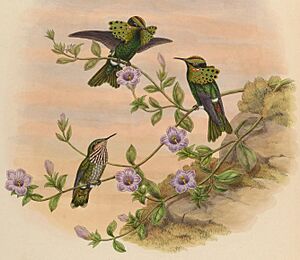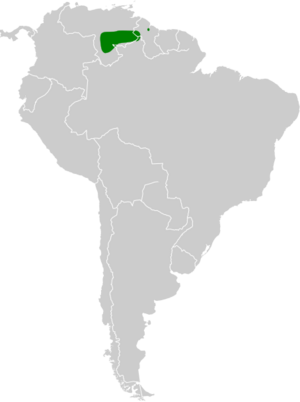Peacock coquette facts for kids
Quick facts for kids Peacock coquette |
|
|---|---|
 |
|
| Conservation status | |
| Scientific classification | |
| Genus: |
Lophornis
|
| Species: |
pavoninus
|
 |
|
The peacock coquette (Lophornis pavoninus) is a tiny, colorful hummingbird found in parts of South America. It's known for its bright feathers and unique appearance, especially the male's fancy "cheek tufts." These birds are part of a group called "coquettes." You can find them in countries like Brazil, Guyana, and Venezuela.
Contents
About the Peacock Coquette
Scientists group animals together based on how they are related. The peacock coquette is a type of hummingbird. For a while, it was grouped with another bird called the festive coquette. Scientists also thought the butterfly coquette was just a type of festive coquette. Now, they are all seen as separate but related species.
There are two main types, or subspecies, of the peacock coquette:
- L. p. pavoninus (the most common type)
- L. p. duidae
What Does It Look Like?
The peacock coquette is a small bird, about 9.7 centimeters (3.8 inches) long. It's quite striking!
Male Peacock Coquette
The male bird of the common subspecies (L. p. pavoninus) is very flashy.
- Its head is a shiny golden green. It has a black line running down the middle.
- Its back is a shiny dark green. There's a white band across its lower back.
- The tail is a purplish bronze color and slightly forked.
- The most special part is its long, shiny green cheek tufts. These tufts have big blackish-blue spots at the ends.
- It also has a reddish-brown patch with a white dot near its eye.
- Its belly is grayish green.
Female Peacock Coquette
The female looks a bit different from the male.
- She does not have the fancy cheek tufts.
- Her back is golden bronze. She also has a buffy white band across her lower back.
- Her tail is grayish. The tail feathers have a wide purplish-bronze band near the end. The very tips of the outer feathers are white.
- Her throat is white with black streaks.
- The rest of her belly has a mix of black, white, and green spots.
L. p. duidae Subspecies
The L. p. duidae subspecies looks a lot like the common type. However, the black line on its head and the reddish-brown patch on its cheek are smaller.
Where Do They Live?
The peacock coquette lives in specific areas of South America.
L. p. pavoninus Habitat
This subspecies is found in:
- Southeastern Venezuela (in Bolívar state, especially on Cerro Ptari-tepui and in Sierra de Lema).
- Mount Roraima, which is a mountain where Venezuela, Brazil, and Guyana meet.
- The Merumé Mountains in Guyana.
L. p. duidae Habitat
This subspecies lives on Cerro Duida and other smaller mountains called tepuis. These are in southeastern Venezuela's Amazonas state.
Preferred Environment
These hummingbirds like to live inside rainforests and cloud forests. They also hang out in clearings and at the edges of these forests. You can find them at high places, usually between 500 and 2000 meters (about 1,600 to 6,500 feet) above sea level.
Behavior and Life Cycle
Movement
Scientists believe the peacock coquette usually stays in one place. However, it seems to move around or migrate in the Sierra de Lema area.
Feeding Habits
The peacock coquette mostly sips nectar from flowers high up in the forest trees. It usually feeds alone. Sometimes, you might see small groups feeding together. They also eat tiny arthropods, which are small bugs. They seem to pick these bugs off leaves.
Reproduction and Nesting
We don't know exactly when the peacock coquette's nesting season is. The female bird builds a cup-shaped nest. She hangs it from a horizontal tree branch, usually about 2 meters (6.5 feet) off the ground. A female usually lays two eggs. The eggs hatch after about 13 to 14 days. The young birds leave the nest about 20 days after they hatch.
Sounds and Calls
Scientists have not yet described the sounds the peacock coquette makes. As of early 2022, there are no known recordings of its calls.
Conservation Status
The IUCN (International Union for Conservation of Nature) has listed the peacock coquette as a species of "Least Concern." This means it is not currently considered to be in danger of disappearing. We don't know the exact number of these birds or if their population is growing or shrinking.
The places where they live, especially on top of the tepuis, are mostly untouched by humans. Because of this, scientists haven't found any immediate threats to the peacock coquette.


